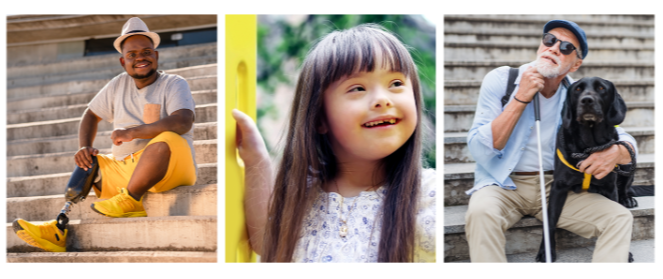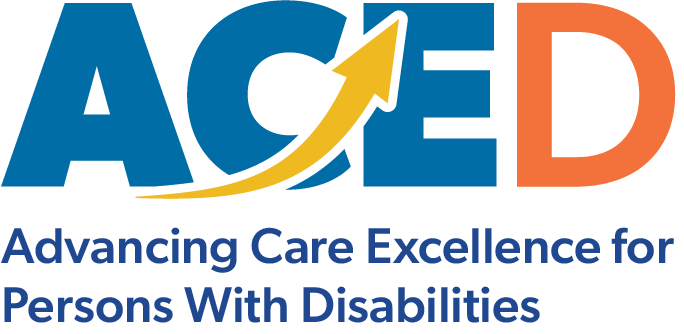Communicating with People with Disabilities
Communicating with People with Disabilities©
Failure of health care providers to communicate effectively and appropriately with people with disabilities is a major barrier to delivery of quality health care for people with disabilities. The information in this document identifies general issues for communication with all people with disabilities followed by issues that may be specific to individuals with a variety of disabilities. If you are uncomfortable or unfamiliar with communication strategies, learn more about specific types of disability to increase your comfort level and communication skills.
General Recommendations for Communicating with All Persons with Disabilities:
- Talk to persons with disabilities in the same way and with a normal tone of voice (not shouting) as you would talk to anyone else.
- Avoid being self-conscious about your use of wording such as “Do you see what I mean?” when talking to someone with vision impairment.
- Talk to people with disabilities as adults and talk to them directly rather than to an accompanying person.
- Ask the person with a disability if assistance is needed; do not assume that help is needed until you ask.
- Use “people-first language”: refer to “a person with a disability” rather than “the disabled person” or “the disabled”.
- When communicating with a person with a disability, it is important to take steps to ensure that effective communication strategies are used. This includes sitting or standing at eye level with the patient and making appropriate eye contact.
Recommendations for Communicating with Patients with Mobility Limitations
- Keep in mind that the personal space of a person with a disability includes the person’s wheelchair, scooter, crutches, walker, cane, or other mobility aid.
- Do not push or move a person’s wheelchair or grab a person’s arm to provide assistance without asking first.
- When speaking to a person seated in a wheelchair or scooter, sit so that you and the person are at the same eye level.
- When giving directions to people with mobility limitations, consider distance, weather conditions, and physical obstacles such as stairs, curbs, and steep hills.
- Shake hands when introduced to a person with a disability. People who have limited hand use or who wear an artificial limb do shake hands.
Recommendations for Communicating with Patients with Vision Loss
- Identify yourself when you approach a person who has low vision or blindness. Introduce anyone with you to the person with vision loss.
- If the person uses glasses, ensure that they are readily available to the person and that he or she uses them.
- Touch the person's arm lightly when you speak so that he or she knows to whom you are speaking before you begin.
- Face the person and speak directly to him or her. Use a normal tone of voice (avoid shouting).
- Explain when you are leaving the environment.
- When offering directions, be as specific, i.e., “Left about 10 feet” or “Right two yards.” Use clock cues, if the person is accustomed to using this approach: “The door is at 10 o'clock.”
- When you offer to assist someone with vision loss, allow the person to take your arm. When assistance the person to a chair, place the person's hand on the back or arm of the seat.
- Never pet or otherwise distract a canine companion or service animal unless the owner has given you permission to do so.
Recommendations for Communicating with Patients with Hearing Loss
- Ask the person who is hard of hearing, deaf, or deaf-blind how he or she prefers to communicate and eliminate or minimize background noise and distractions.
- If the person uses an assistive hearing device (hearing aid), ensure that it is readily available to the person and in working order and that he or she uses it.
- If you are speaking through a sign language interpreter, pause occasionally to allow the interpreter time to translate completely and accurately.
- Talk directly to the person who is assisted by a sign interpreter, not to the interpreter, even if the person is looking at the interpreter and does not make eye contact with you.
- Before you start to speak, get the attention of the person you are addressing. Visual (wave) or tactile signals (light touch) can be used to get the person's attention.
- Speak without exaggerating your words. Do not raise your voice, unless you are specifically requested to do so. Speak in a normal tone without shouting.
- If the person lip reads (speech reads), face the person and keep your hands and other objects away from your mouth. Maintain eye contact. Do not turn away or walk around while talking.
- Consider that written English may not be the primary language for some people with disabilities and make appropriate accommodations in communicating with them.
- Anticipate that only 30% of lip reading (speech reading) will be understood because of its level of difficulty; be prepared to repeat information or questions.
- Ask the person for feedback or to repeat what you have said to assess understanding.
- If you do not understand something that is said, ask the person to repeat it or to write it down. Do not pretend to understand if you do not.
Recommendations for Communicating with Patients with Speech Disabilities or Speech Difficulties
- Talk to people with speech disabilities as you would talk to anyone else; use your regular tone of voice without shouting.
- Be patient because it may take the person extra time to communicate. Do not speak for the person or complete the person’s sentences.
- Give the person your undivided attention and eliminate background noise and distractions.
- If the person uses a communication device, such as a manual or electronic communication board, ask the person the best way to use it.
- Do not pretend to understand if you do not. Tell the person you do not understand what he or she has said and ask the person to repeat the message, spell it, tell it in a different way, or write it down. Use hand gestures and notes.
- Repeat what you understand and note the person's reactions, which can indicate if you have understood correctly.
- Develop a specific communication strategy that is consistent with the person’s abilities: nod of the head or blink to indicate agreement or disagreement with what you have asked or said.
- To obtain information quickly, ask short questions that require brief answers or a head nod. Avoid insulting the person's intelligence with oversimplification.
Recommendations for Communicating with Patients with Intellectual, Cognitive or Developmental Disabilities
- Treat adults with intellectual, cognitive or developmental disabilities as adults.
- Adjust your method of communication as necessary depending on the individual's responses to you. Use simple, direct sentences or supplementary visual forms of communication, such as gestures, diagrams, or demonstrations, if indicated.
- Use concrete, specific language. Avoid abstract language and simplistic wording. When possible, use words that relate to things you both can see. Avoid using directional terms such as right, left, east, or west.
- Be prepared to repeat the same information more than once in different ways.
- When asking questions, phrase them without suggesting desired or preferred responses as some people with intellectual, cognitive or developmental disabilities may tell you what they think you want to hear.
- Give exact instructions. For example, “You will see the nurse at 10:30,” rather than “Come back to see the nurse in 15 minutes.”
- Avoid giving too many directions at one time, which may be confusing. Eliminate distractions and minimize background noise if possible.
- Avoid sensory overload by providing information gradually and clearly.
- Provide information in written or verbal form if that is the person’s preference.
- Recognize that the person may need to have directions repeated and may take notes to help remember directions or the sequence of tasks. He or she may also benefit from watching a task demonstrated.
- Do not pretend to understand if you do not. Ask the person to repeat what was said. Be patient, flexible, and supportive.
- Do not assume that the person will be able to read well; some may not read at all.
Recommendations for Communicating with Patients with Psychiatric/Mental Health Disabilities
- Approach the person as you would anyone else; speak directly to the person, using clear, simple communication.
- Treat persons who are adults as adults. Do not patronize, condescend, or threaten when communicating with the person.
- Do not make decisions for the person or assume that you know the person's preferences.
- Offer to shake hands when introduced. Use the same good manners in interacting with a person who has a psychiatric/mental health disability that you would with anyone else.
- Make eye contact, and be aware of your own body language. Like others, people with psychiatric/mental health disabilities will sense your discomfort.
- Listen attentively, and wait for the person to finish speaking. If needed, clarify what the person has said.
- Do not pretend to understand if you do not. Ask the person to repeat what was said. Be patient, flexible, and supportive.
- Recognize that a person with psychiatric/mental health disabilities often has the same wants, needs, dreams, and desires as anyone else.
References & Online Resources
Sharts-Hopko, N. C., Smeltzer, S., Ott, B. B., Zimmerman, B., & Dufin, J. (2010). Healthcare experiences of women with visual impairment. Clinical Nurse Specialist, 24(3), 149-153. doi:10.1097/NUR.0b013e3181d82b89
http://www.thearc.org/who-we-are/media-center/people-first-language
http://www.inclusionproject.org/nip_userfiles/file/People%20First%20Chart.pdf
https://www.cdc.gov/ncbddd/disabilityandhealth/pdf/disabilityposter_photos.pdf
http://www.ouhsc.edu/Portals/1154/EasyDNNnews/Uploads/4232/11_PeopleFirstLanguageSheet.pdf
Copyright: Suzanne C. Smeltzer, Bette Mariani & Colleen Meakim of Villanova University College of Nursing, January 28, 2017. Revised 12/5/2023.
Users are asked to cite the source for these Villanova University developed resources as developed by the Villanova University College of Nursing and retrieved on the NLN website.


